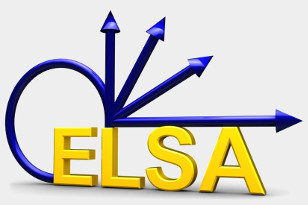
| |
| ELSA-Facility | |
| Accelerator physics: | |
| Home page | |
| Group members | |
| Accelerator | |
| Research & development | |
| Publications | |
| Teaching | |
| Experiments at ELSA: | |
|
|
Hadron physics |
| Polarized target | |
| Test beam | |
| Informations for users: | |
| Beam schedule | |
| Accelerator status | |
| SFB/Transregio 16 | |
| Radiation protection | |
| Job offers | |
| Additional links | |
| Guided tours | |
| Contact | |
 |
Deutsche Version |
Hadron Physics
The research programs in the hadron physics section are done by several collaborations, which are all working with external beams:
Collaborations, currently taking data:
Crystal Barrel at ELSA and TAPS (started in fall 1999)
The Crystal Barrel detector was initially used at LEAR (CERN) and has been modified for the conditions at ELSA. For the first two data acquisition periods, the detector was built up at the former SAPHIR area. Since 2001 the detector is supplemented by the TAPS detector, which is used for the detection of particles under forward angles. The collaboration investigates the photoproduction of meson resonances (search for missing resonances, exploring the decay modes of known resonances and looking for less established resonances). Its results will help to understand QCD at low energies.
After the end of the second data acquisition period (end of 2003) the detector was moved to the former ELAN/GDH area. At this occasion extensive improvements and modification of the detector and the data acquisition system were made. At the new area, measurements with polarized target and polarized electron beam (production of circularly polarized photons) are feasible. The modfications are now finished and the data acquisition has been started, the first double polarized mearsurements were carried out in summer 2007.BGO-OD
This collaboration investigates the photoproduction of mesons off nucleons. The detector system consists mainly of the BGO-ball detector (consisting of 480 modules, 11.3 sr acceptance), a dipole magnet with large angular acceptance (horizontal 12°, vertical 8°) in forward direction for momentum separation, followed by eight drift chambers and four time-of-flight detectors for track reconstruction.
Collaborations, data acquisition finished:
-
GDH at ELSA (summer 1998 till spring 2002)
This collaboration makes use of polarized photons (generated by bremsstrahlung of polarized electrons) and a polarized target. It will provide an experimental test of the Gerasimov-Drell-Hearn sum rule, which links the anomalous magnetic moment of the proton to the difference of the integrated cross sections for the absorption of photons with spins parallel and antiparallel to that of the proton. The energy range of up to 800 MeV has been covered at MAMI in Mainz, and higher energies of up to 3.0 GeV were investigated at ELSA in Bonn. ELAN (until 1997),
an electron scattering facility on hydrogen, deuterium or similar targets (that could be polarized) with a magnetic spectrometer for detection of the scattered electrons and a TOF detector for the hadronic fragment(s).
This collaboration was working with external beam currents of up to 50 nA at energies between 0.8 and 2.6 GeV. The duty factor, describing the quality (mainly time independence of intensity) of the extracted beam was about 65% for this experiment (up to 99% during the extraction time).SAPHIR (until 1998)
This collaboration used a magnetic wide angle (4*π) detector with multiwire central drift chamber (CDC) enclosed in a large magnet, forward and sideward drift chambers, electromagnetic calorimeter and scintillating TOF detectors worked with tagged photons, which were generated by bremsstrahlung of extracted electrons on a thin foil.
The detector worked with low intensities (in the region of 100 pA electron current in front of the tagging target), but at energies of up to 2.8 GeV. The overall duty cycle with respect to both the microstructure of the extracted beam and the ratio of extraction to total cycle time was in the region of 90%. The data acquisition ran until 1998 and the detector has now been dismantled.
In fall 1996 a group from Frascati performed some measurements concerning total photoabsorption cross sections on different nuclear targets at the SAPHIR experimental place.
 Printer version
Printer version
|
 Deutsche Version
Deutsche Version
|
Imprint | Data privacy statement |